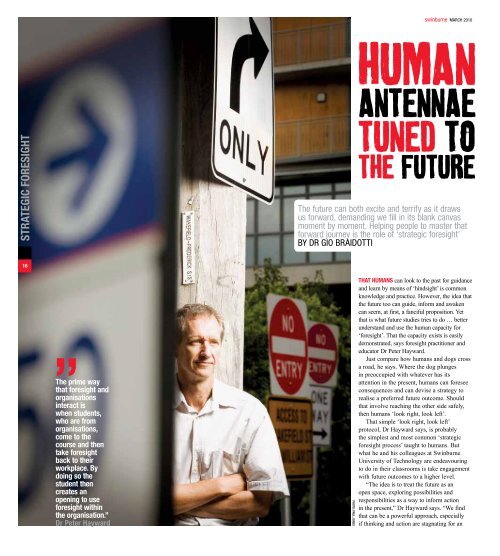March 2010 - Swinburne University of Technology
March 2010 - Swinburne University of Technology
March 2010 - Swinburne University of Technology
Create successful ePaper yourself
Turn your PDF publications into a flip-book with our unique Google optimized e-Paper software.
swinburne <strong>March</strong> <strong>2010</strong><br />
strategic foresight<br />
The future can both excite and terrify as it draws<br />
us forward, demanding we fill in its blank canvas<br />
moment by moment. Helping people to master that<br />
forward journey is the role <strong>of</strong> ‘strategic foresight’<br />
By Dr Gio Braidotti<br />
16<br />
,,<br />
The prime way<br />
that foresight and<br />
organisations<br />
interact is<br />
when students,<br />
who are from<br />
organisations,<br />
come to the<br />
course and then<br />
take foresight<br />
back to their<br />
workplace. By<br />
doing so the<br />
student then<br />
creates an<br />
opening to use<br />
foresight within<br />
the organisation.”<br />
Dr Peter Hayward<br />
Photo: Paul Jones<br />
That humans can look to the past for guidance<br />
and learn by means <strong>of</strong> ‘hindsight’ is common<br />
knowledge and practice. However, the idea that<br />
the future too can guide, inform and awaken<br />
can seem, at first, a fanciful proposition. Yet<br />
that is what future studies tries to do … better<br />
understand and use the human capacity for<br />
‘foresight’. That the capacity exists is easily<br />
demonstrated, says foresight practitioner and<br />
educator Dr Peter Hayward.<br />
Just compare how humans and dogs cross<br />
a road, he says. Where the dog plunges<br />
in preoccupied with whatever has its<br />
attention in the present, humans can foresee<br />
consequences and can devise a strategy to<br />
realise a preferred future outcome. Should<br />
that involve reaching the other side safely,<br />
then humans ‘look right, look left’.<br />
That simple ‘look right, look left’<br />
protocol, Dr Hayward says, is probably<br />
the simplest and most common ‘strategic<br />
foresight process’ taught to humans. But<br />
what he and his colleagues at <strong>Swinburne</strong><br />
<strong>University</strong> <strong>of</strong> <strong>Technology</strong> are endeavouring<br />
to do in their classrooms is take engagement<br />
with future outcomes to a higher level.<br />
“The idea is to treat the future as an<br />
open space, exploring possibilities and<br />
responsibilities as a way to inform action<br />
in the present,” Dr Hayward says. “We find<br />
that can be a powerful approach, especially<br />
if thinking and action are stagnating for an
















